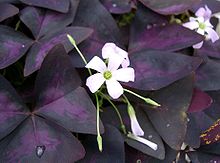- Oxalis triangularis
-
Oxalis triangularis 
Scientific classification Kingdom: Plantae (unranked): Angiosperms (unranked): Eudicots (unranked): Rosids Order: Oxalidales Family: Oxalidaceae Genus: Oxalis Species: O. triangularis Binomial name Oxalis triangularis
A.St.-Hil.Synonyms Oxalis regnellii
Oxalis triangularis, commonly called False Shamrock, is a species of edible perennial plant in the Oxalidaceae family. It is endemic to Brazil[2]. This woodsorrel is typically grown as a houseplant but can be grown outside in zones 8a-11, preferably in light shade.
The subspecies O. triangularis subsp. papilionacea, in particular its cultivar 'Triangularis', is highly popular as a pot plant and known as Love Plant, Purple Shamrock[1], or (like many relatives) "sourgrass"[2].
Contents
Indoor care
They require bright or direct sunlight supplemented with a cool indoor temperature of ~15 degrees celsius. They can tolerate higher indoor temperatures but will go into dormancy prematurely and/or begin to take on a "tired" appearance if temperatures go above 27 degrees celsius for prolonged periods of time. Use average potting soil with good drainage and allow the surface soil to dry out between waterings. Mature False Shamrock plants are cut back to the soil every 3–5 years in early summer or during the domancy period. Young plants are cut back to the soil every year in early summer or during the dormancy period, until they reach maturity.
Propagation
Oxalis Triangularis are plants that grow from bulbs, and their propagation is done by division of the bulbs. Like other bulbs, the oxalis go through dormancy periods on a regular basis; at the end of such period, the bulbs can be unearthed, sidebulbs cut and replanted in appropriate soil, where they will grow into new plants. [3]
Movement
A timelapse of the leaves of O. triangularis closing at night. The recording is at ~750x actual speed and covers a 1.5 hr period of time.
The leaves of O. triangularis move in response to light levels, opening in high ambient light (in the day) and closing at low light levels (at night). This movement is not due to growth and is instead powered by changes in turgor pressure in cells at the base of the leaf. It is an example of photonasty.
References
- Oxalis triangularis
- 2007 IUCN Red List of Threatened Species (for conservation status)
- Zimmerman, Maureen Williams. Sunset House Plants A to Z: How to Choose, Grow and Display Sunset Publishing Corp. 1998. ISBN 0-376-03337-1

This Oxalidales article is a stub. You can help Wikipedia by expanding it.
